Bring in the Big Guns
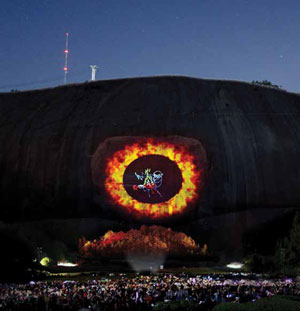
3D and HD Drive Demand for Ultra-Bright Large Venue Projectors
Face it: Living large is everyone’s goal, whether you’re talking lifestyle or AV aspirations. And as clients’ visions grow in scope, not surprisingly, there’s an increasingly wide array of large venue projector (LVP) tools at the ready to accommodate them.
The new and improved show at Georgia’s famed Stone Mountain relies on six Barco FLM HD20 projectors to create a “virtual skin” on the 825-foot-tall granite outcropping. Three Barco High End Systems’ (HES) Axon Media Servers and driven by an HES Road Hog Full Boar console enable the creation of the edge-blended 3D video projections that virtually simulate a 5,500-inch HD resolution TV screen.
“Large,” of course, is a subjective term. The definition of what constitutes an LVP scenario can vary depending on whom you’re talking to, with everything from room capacity to the physical size of the accommodating venue being taken into account. At Digital Projection, for example, the initial criteria for large venue imagery is a screen size of about 12-foot surface width, with ambient light levels also a key consideration.
“Examples of venues that regularly need high-lumen projectors include houses of worship, which typically contain a good deal of ambient light due to large windows and open sanctuaries,” said Chuck Collins, VP of sales with Digital Projection. “Education environments as well, especially in auditoriums and collegiate environments where reading resource literature and viewing projected content typically commingle. Museums are an obvious choice, as there’s typically a good deal of peripheral light from other exhibits.”
As Barco sees it, there are clear forces powering the evolution in projectors capable of informing and/or entertaining the crowds that gather at a large venue. “There are two important trends that have driven the development of large venue projectors: brightness and resolution,” said Chris Colpaert, strategic marketing director for ProAV at Barco. “Over the last couple of years we have seen a big shift from 4:3 to HD (or WUXGA) resolution. Lots of rental companies have invested in HD cameras, and this has created a push for full HD resolution. Also in the ProAV world, full HD is becoming mainstream.
“Next to that, people continue to demand more light output: part of this can be explained by the popularity of 3D in digital cinema, which created the necessary buzz in ProAV as well,” Colpaert continued. “Due to the low [brightness] efficiency of the current 3D technology, it is required to use higher-brightness units. But we have also experienced a renewed interest in higherbrightness projection applications, such as outdoor building projection and multi-screen edge-blended projection applications.”
A daily selection of the top stories for AV integrators, resellers and consultants. Sign up below.
Mitsubishi sees LVP not in terms of venue size, but instead as any application requiring 6,000 lumens or brighter, noting that the increasing reliability and flexibility of big projectors apply to large-scale signage as well. “Newer projectors like the Mitsubishi 8000 series available today can run 24-7 and come with dual or quadruple lamps that ensure continuous operations,” explained James Chan, vice president, marketing for Mitsubishi. “Plus, the newer algorithms available that are built-in to projectors—allowing geometric corrections and edge blending—have enabled these devices to shine their bright images not only on the traditional flat screen, but on all sorts of creative surfaces.”
Cost effectiveness is always a factor for installers and clients, while manufacturers are striving harder to strike a balance between brightness and environmental impact. “As our customer base becomes more cost-conscious we have developed more cost-effective projectors,” Digital Projection’s Collins said. “We have specifically been working on advancements in our illumination technology. In the past, ‘high brightness’ meant the use of Xenon lamps were a necessity, but Xenon lamps are very expensive, and frankly, can be fairly tough on the environment. It’s true that Digital Projection still offers xenon-based projectors for our customers that need maximum brightness, but for our clients that need a more affordable high brightness alternative, our optical scientists in the U.K. have innovated a revolutionary new four-lamp illumination system.

A 777 flight simulator uses multiple Digital Projection dVision 30 projectors on a 180-degree curved screen.
“With our unique alignment of the quad lamp system,” Collins added, “we have created an incredibly compact projector chassis that captures unprecedented amounts of light to create a super-efficient 16,000-lumen projector. As we shrink our illumination technologies, we’re able to also shrink the overall footprint of our projectors, resulting in the ability to place brighter projectors like our Titan Quad projectors in small spaces.”
The benefits of these innovations spill off the projection surface and affect the space an LVP is in, allowing clients to make more of their installations. “Higher resolution and higher brightness allows the consultant and installer to specify bigger screen sizes, with less projectors or wide-screen projections with less units,” said Colpeart of Barco. “This drives down the investment cost and the electricity cost. The total cost of operation (TCO) is also positively affected by the higher lamp lifetime of the Xenon lamps. More and more designers and consultants are going away from the traditional projection on screens: With high-resolution, highbrightness DLP projectors, the full room comes at your disposal and very immersive environments can be created.”
All of the above becomes crucial when clients have mission-critical applications like medical education. As Director of Education Technology for the University of Central Florida for 10 years, Ron Knappenberger specified LVP’s such as the Mitsubishi 8200 to make absolutely sure instructors’ messages were getting across. “When you’re dealing with cell structures and intricacies of the human body, you need to have sufficient resolution and brightness for good detail,” said Knappenberger, who now holds the post of integrated technologies project manager for Greenville Hospital Systems, Greenville, SC. “And in a large venue you want to make sure the LVP is bright enough without all the lights turned off, since not all class materials are projected all the time: Students also have to take notes, and see the instructor and the whiteboard in the front of the room.”
As Knappenberger pointed out, however, quantity is nothing without quality. “You need to make sure you have adequate detail when projecting to large venues. The LVP can be as big as it wants—but if what you see is not of sufficient quality, it will not work.”
David Weiss (www.dwords.com) writes extensively about AV, audio, and broadcast technology.
Margin Builder
“The key to increasing margin in any sale is to accessorize,” said Chuck Collins of Digital Projection. “As base as the comparison may seem, fast-food establishments have mastered the art of the accessorized sale, suggesting a customer try a specific new drink or ‘super-size’ a meal. The same goes with an AV transaction, and in our case a projector sale.” Accessories integrators can offer include enhanced warranty programs, rigging frames, external warp and blend devices, lamps, and ceiling mounts.
Panasonic PT-EX16KU

The PT-EX16KU is part of Panasonic’s first line of projectors developed in collaboration with Sanyo. The PT-EX16KU LCD projector, featuring 16,000 lumens of brightness XGA resolution, is added to the large venue lineup for houses of worship, mid-sized rental and staging, and customers seeking high brightness large venue projection images for moderate use.
InFocus IN5312 and IN5314
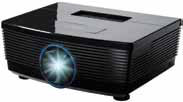
The IN5312 and IN5314 allow customers to custom-fit installations to meet unique space requirements or applications. Three different lens choices—standard zoom, short throw long throw, as well as horizontal and vertical lens shift—help users position the image exactly where it needs to be, and offer extra flexibility in determining the optimal projector placement. The IN5300 series offers exceptional image quality, and users can choose from native WXGA resolution, or select native XGA resolution for legacy installations.
DPI Titan Quad
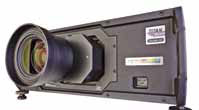
Incredibly compact for its lumen performance, the Titan Quad platform incorporates DP’s active 3D connectivity, advanced image warp and blend capabilities, various native resolutions, and other professional features to suit almost any commercial or staging application imaginable. The Titan Quad range marks the world’s first projectors of this brightness in a chassis with such a small form factor. All Titan Quad models provide the user with the ability to make extensive geometric warp correction via the adjustment of an interpolated grid array of up to 16 x 16 nodes.
NEC PH1000U

The PH1000U digital 3-chip DLP system is an 11,000 lumen WUXGA resolution projector featuring a sleek compact design that creates quality images under virtually any operating condition. It offers an open pluggable specification (OPS), which is the first industry-wide standardization in option slots to simplify installation, use, and maintenance while offering input flexibility. It supports multiple input cards, including an HD/SD-SDI, and single board computer (SBC). The PH1000U uses integrated device technology HQV, a high-performance video processing and scaling system designed for computer signals, as well as standard or high-definition video.
LG CD181D
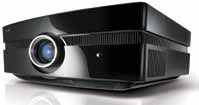
The CD181D projector is appropriate for an auditorium or large meeting room that requires high brightness and 120 hertz full HD resolution. The CF181D features 35,000:1 contrast, 1,800 ANSI lumens brightness, and multiple connectivity options. Two HDMI inputs and one USB port connect the CF181D to video devices. Equipped with a number of video control and image enhancement technologies, such as Iris Auto and TruMotion Demo, the CF181D can be precisely fine-tuned.
Sharp XG-PH80
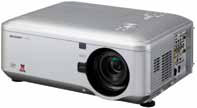
The XG-PH80 large venue projector supports 3D, as well as WXGA sources in 1,280 x 720 resolution with 60 hertz and 120 hertz, and it is fully compatible with traditional 2D sources. A dual lamp system allows users to choose lamp arrangement to suit specific needs. Options include single or dual lamp projection, and standard brightness or eco mode. Sharp’s dual lamp system also provides redundant reliability, so if one lamp fails, the other can step in without any interruption. The XG-PH80 is equipped with a range of analog and digital input terminals, including 15-pin and 5-BNC RGB/component video and HDCP compliant DVI.
Mitsubishi XD8100U and WD8200U

The XD8100U XGA (1,024 x 768 pixels) and widescreen WD8200U WXGA (1,280 x 800 pixels) can operate in either single or dual lamp mode for a sharp and bright image (up to 7,000 lumens and 5,000 lumens, respectively). Each lamp needs only one hour of shutdown period every week, which enables users to configure lamp settings appropriate for applications that run non-stop or in areas with variable ambient light. Each model in this line is equipped with Mitsubishi Super Resolution, a menu-driven Mitsubishi Electric algorithm where the user can enhance the sharpness of a projected image.
Sony SRX-T420
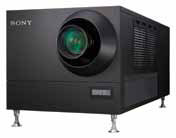
Sony’s line of ultra-high resolution 4K SXRD projectors includes the SRX-T420, designed to deliver enhanced performance and flexibility in large-venue commercial applications. The model incorporates the same 4,096 x 2,160 resolution of its SXRD counterparts with similar design and control elements for user-friendliness. However, in addition to its high brightness, it delivers an enhanced contrast ratio of 3,000:1, as well as a range of new improvements in performance, interface capability, control software, and installation capabilities. The T420 can be fitted with lenses from other models in the SRX series line, and the SRX-C Windows-based controller software allows control of multiple projectors over an ethernet connection from a single workstation.
Optoma TH7500

The TH7500 is Optoma’s first dual lamp multimedia projector that delivers the high brightness, superior reliability, and rugged construction that are ideal for rental and staging installations. With up to 6,000 lumens and offering a selection of five lenses and a bevy of high performance features, the TH7500 delivers spectacular images in HD resolution in just about any operating environment. The dual lamp design offers high brightness and functional redundancy, making it an appropriate choice for installations where 24/7 reliability is key.
BenQ SH960

Designed for use in the most demanding settings, the SH960 utilizes 1080p native resolution and BrilliantColor technology. With brightness of 5,500 ANSI lumens, the SH960 projects brilliant images even in the presence of ambient light. The SH960 is equipped with a 3,000:1 contrast ratio and a native 16:9 aspect ratio with a full 1.07 billion-color palette. The projector’s dual-lamp design allows users to opt for maximum brightness or choose an eco-mode that extends lamp life by up to 30 percent.
Eiki LC-X800
Eiki’s latest Powerhouse series projector, the LC-X800 is capable of 12,000 ANSI lumens at 90 percentplus uniformity with a 4,000:1 contrast ratio. The projector is compatible with normal and widescreen input resolutions up to WUXGA and 1080p, supporting both analog and digital computer and video input in all color standards. Other features include vertical and horizontal lens shift, 10-bit color processing, mechanical shutter for black screen no show, a self-advancing cartridge air filter, RS-232 compatibility, and wireless/wired remote control.
Epson PowerLite Pro G5450WUNL and G5750WUNL

The PowerLite Pro G5450WUNL and G5750WUNL were designed for medium to large custom installations in corporations, higher education, and houses of worship. They are both WUXGA projectors, delivering 1,920 x 1,200 native resolution and high-quality widescreen images. The PowerLite Pro G5450WUNL offers 4,000 lumens of color and white light output and the PowerLite Pro G5750WUNL offers 4,500 lumens of color and white light output. Other features include six-axis color adjustment, split screen, multi-PC projection, Crestron RoomView capability, and advanced connectivity with two digital inputs—HDMI and DVI-D, a computer VGA port, two audio-in, USB, hardwire remote, five BNC, monitor out, RS-232, and Quick- Connect wireless.
Barco HDX-W14 and HDX-W12

Barco’s HDX-W14 combines active 3D and both wired and wireless control options in one unit. In addition, it offers quick control through smartphones and mobile tablet devices. Its sturdy, compact design allows the HDX-W14 to be ready for use quickly while its 14,000 lumens light output and three-chip DLP color quality ensures crisp imagery on any screen. The HDXW12 features 12,000 lumens light output. Both models can project from any position or angle, and onboard image processing technology is reflected in a quick preview mode on a color LCD screen. Both the HDX-W14 and the HDX-W12 have a WUXGA resolution. The HDX-W12 is unique in offering a bright xenon lamp with a 2,500- hour lifetime, which gives it a significant edge over competitive products with mercury lamps.
